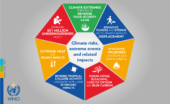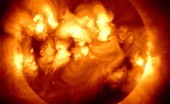Johannah Bernstein post: "eternally proud of my father’s extraordinary aeronautical engineering. legacy. here is a photo of the Canadair Water…
Beijing’s Olympic Quest: Turn Smoggy Sky Blue
Written by Diana Thebaud Nicholson // December 29, 2007 // China, Environment & Energy, Government & Governance, Olympics // Comments Off on Beijing’s Olympic Quest: Turn Smoggy Sky Blue
China’s unsolved riddle is how to reconcile fast economic growth with environmental protection. But Beijing’s Olympic deadline means the city needs an immediate answer. The ruling Communist Party envisions the Games as a public relations showcase and is leaving no detail untended. Now Beijing is also going to try to manipulate air quality. For months, scientists have treated the city like a laboratory, testing wind patterns and atmospheric structure, while pinpointing local and regional pollution sources. Olympics contingency plans have been approved for Beijing and surrounding provinces. Details are not public, but officials have discussed shutting down factories and restricting traffic during the Games.
(NYT) BEIJING — Every day, monitoring stations across the city measure air pollution to determine if the skies above this national capital can officially be designated blue. It is not an act of whimsy: with Beijing preparing to play host to the 2008 Olympic Games, the official Blue Sky ratings are the city’s own measuring stick for how well it is cleaning up its polluted air.
For the world’s Olympians, Beijing’s air is a performance issue. The concern is that respiratory problems could impede athletic performance and prevent records from being broken. For the city’s estimated 12 million residents, pollution is an inescapable health and quality-of-life issue. Skepticism about the validity of the Blue Sky ratings is common. Moreover, the concern is whether the city can clean itself up long after the Games are over.
Beijing has long ranked as one of the world’s most polluted cities. To win the Games, Beijing promised a “Green Olympics” and undertook environmental initiatives now considered models for the rest of the country. But greening Beijing has not meant slowing it down. Officials also have encouraged an astonishing urbanization boom that has made environmental gains seem modest, if not illusory.
Polluting factories have been moved or closed. But auto emissions are rising – an explosion of car ownership has wrought gridlocked traffic and a halo of auto fumes. Beijing now has more than three million vehicles and is adding more than 400,000 new cars and trucks each year. Dirty, coal-burning furnaces have been replaced, lowering the city’s sulfur dioxide emissions. But fine-particle pollution has been exacerbated by a staggering citywide construction binge that shows no signs of letting up. Complete article



